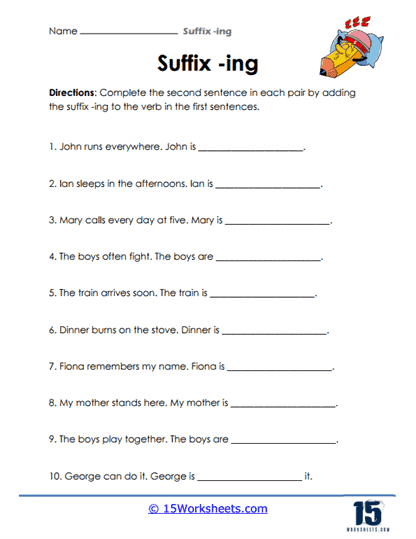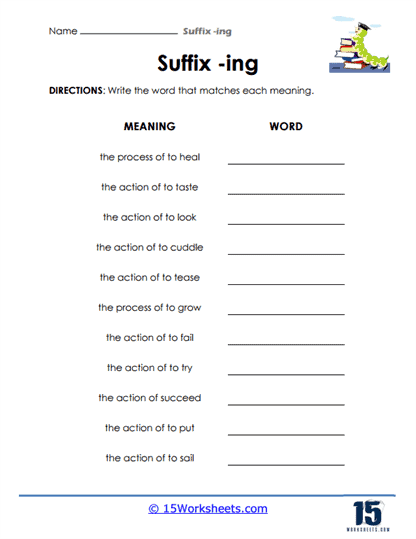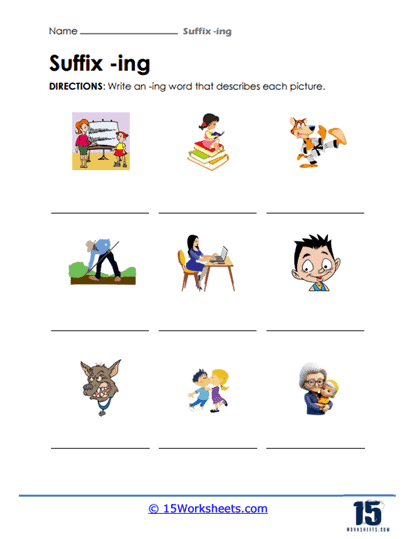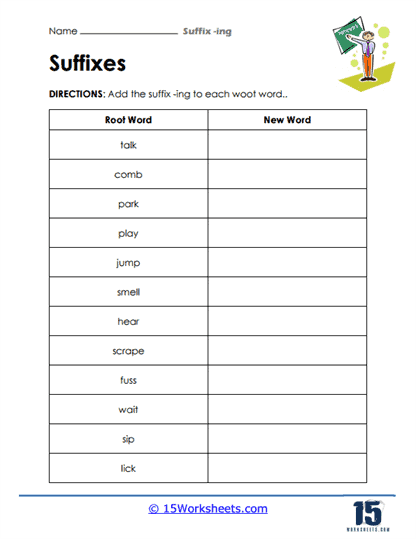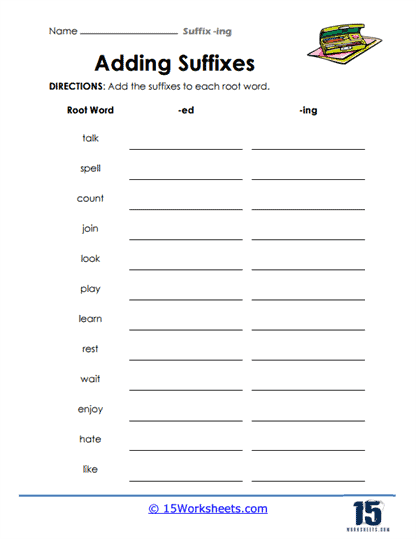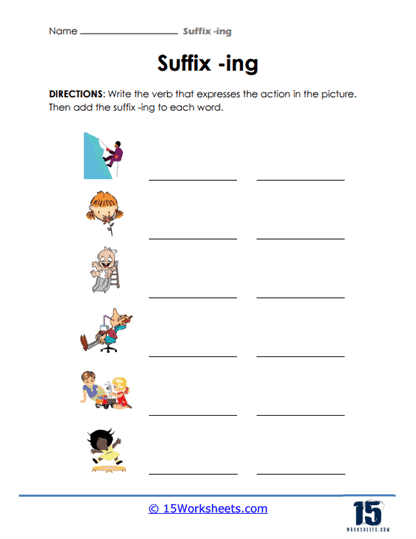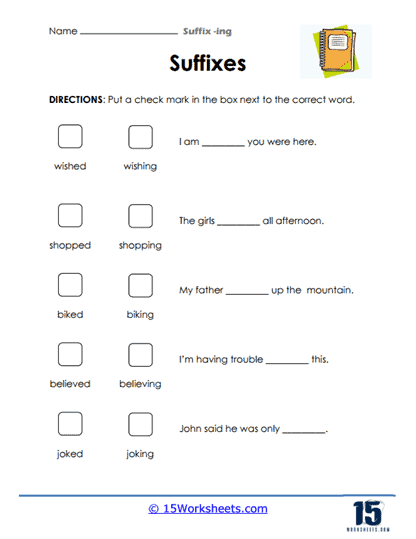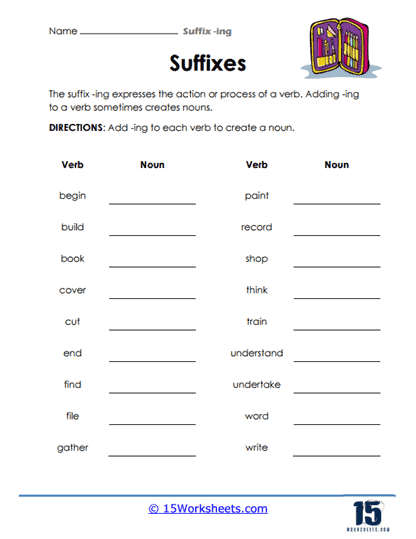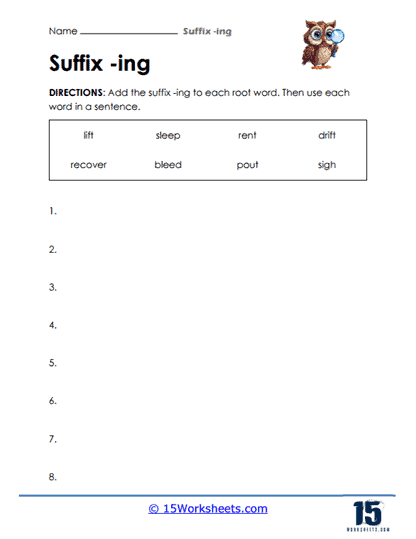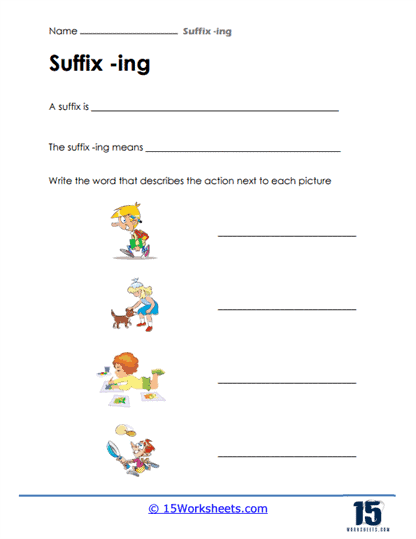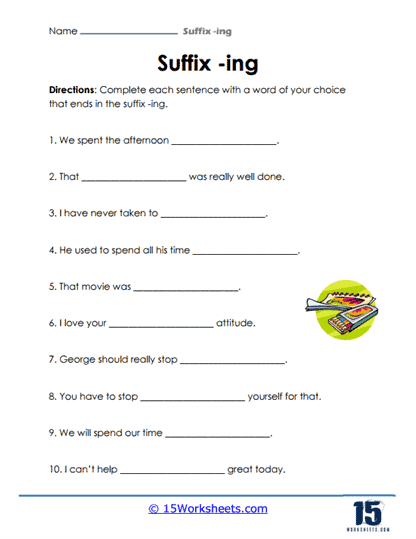Suffix -ing Worksheets
About These 15 Worksheets
Mastering the intricacies of English grammar can be a challenge for many learners, but understanding specific elements like the “-ing” suffix is crucial for achieving fluency. These specially designed worksheets are more than just a set of exercises-they are a comprehensive tool that will guide students through the process of grasping and effectively using the “-ing” suffix, a foundational aspect of English grammar.
In English, the “-ing” suffix serves multiple purposes, playing a vital role in the construction of the present continuous tense, forming gerunds, and acting as participles. Each of these elements is a building block for more advanced language skills. The present continuous tense, for example, allows speakers to express actions happening in the moment, while gerunds turn actions into nouns, expanding the ways learners can express ideas and emotions. Participles, on the other hand, function as both adjectives and parts of compound verb structures, adding richness and flexibility to sentence formation. By mastering the “-ing” suffix, students are not just learning to conjugate verbs; they are unlocking the door to more dynamic, descriptive, and precise communication.
These worksheets go beyond rote memorization of grammar rules. They are thoughtfully structured with a variety of exercises that cater to the diverse ways in which students learn. Some learners thrive on visual cues, others on repetition, and some on applying knowledge through writing. The variety embedded in these exercises ensures that no matter the student’s preferred learning style, they will find methods that resonate with them. Whether through fill-in-the-blank questions, sentence rewrites, or creative writing prompts, the worksheets provide opportunities for active learning and deeper engagement with the language.
Incorporating a range of activities, these worksheets emphasize not only grammar comprehension but also the practical application of the “-ing” suffix. Exercises that require verb conjugation, for instance, help students see the real-time use of the present continuous tense, grounding abstract grammatical concepts in everyday communication. This practical approach bridges the gap between knowing a rule and using it confidently in conversation or writing, which is essential for language learners at any level.
These worksheets are created to encourage critical thinking about language. They challenge students to analyze how the “-ing” suffix can shift the meaning of a verb, transforming it into a continuous action or converting it into a noun. By doing so, learners begin to appreciate the flexibility of English, understanding that language is not just about rules but about creativity and expression. This level of engagement cultivates not only grammatical understanding but also a more profound appreciation for the subtleties of the language.
What sets these worksheets apart is their focus on incremental skill-building. Each exercise is a stepping stone, guiding students from basic comprehension to more advanced usage. For beginner students, the worksheets provide clear, accessible explanations of how and when to use the “-ing” suffix, ensuring that learners grasp the fundamentals before moving forward. For more advanced students, the worksheets offer complex sentence structures and nuanced applications of the “-ing” suffix, pushing them to refine their writing and speaking skills further.
The targeted nature of these worksheets makes them an indispensable resource for students at various stages of their English language journey. For beginners, the worksheets serve as an introduction to key grammatical concepts, providing a strong foundation upon which to build. Intermediate learners will find that the exercises help solidify their understanding, allowing them to move from passive recognition of grammar rules to active use. For advanced learners, the worksheets offer an opportunity to fine-tune their language proficiency, particularly in writing, where the nuances of verb forms, gerunds, and participles can dramatically affect the clarity and elegance of their sentences.
Beyond grammar, these worksheets also contribute to the overall development of language skills. By practicing with the “-ing” suffix in different contexts, students improve not only their grammar but also their reading and writing abilities. Writing exercises, for example, encourage students to craft sentences that are not only grammatically correct but also rich in meaning and variation. This promotes fluency and helps learners develop a more natural feel for the rhythm and structure of the English language.
Types of Exercises
Adding “-ing” to Verbs – These exercises require students to transform base verbs into their “-ing” form. For instance, turning “run” into “running.” This basic exercise helps students understand how to correctly form the present participle. Students are given sentences with missing words where they must insert the correct “-ing” form of a verb. This type of exercise helps in practicing the use of the present continuous tense and gerunds within a context.
Sentence Rewriting – Students rewrite sentences in the present continuous tense. For example, changing “She reads a book” to “She is reading a book.” This enhances understanding of tense transformation. Students identify and correct errors in the use of the “-ing” form in given sentences. This helps in recognizing and rectifying common mistakes.
Matching Exercises – These exercises may involve matching base verbs to their “-ing” forms or matching sentence beginnings with appropriate “-ing” phrase endings.
Creating Sentences – Students use given “-ing” verbs to create their own sentences. This fosters creativity and contextual understanding. Exercises where students group verbs based on similar rules for adding “-ing” (like doubling the final consonant or dropping the final “e”).
The Benefits of These Worksheets
Enhanced Understanding of Verb Tenses – These worksheets help students grasp the nuances of the present continuous tense, an essential aspect of English grammar. Regular practice strengthens a student’s overall grammar skills, particularly in verb conjugation and sentence structure. By using verbs in various sentences and contexts, students not only learn the forms but also how to apply them in different scenarios.
Error Recognition and Correction – Identifying and fixing errors in exercises enables students to recognize common mistakes and learn the correct usage, enhancing their writing and speaking abilities. With a better grasp of verb forms and tenses, students can write more fluently and coherently, with improved sentence structure and clarity.
Vocabulary Development – These exercises often introduce new vocabulary, aiding in the expansion of the student’s language repertoire. Mastery of a fundamental component of English grammar builds confidence in language use, encouraging more active participation in both written and spoken English.
List of Suffix -ing
Baking
Boating
Camping
Cleaning
Climbing
Cooking
Cycling
Dancing
Eating
Editing
Exercising
Exploring
Fighting
Filming
Fishing
Flying
Gardening
Hammering
Hiking
Hunting
Jumping
Laughing
Navigating
Painting
Playing
Quilting
Racing
Reading
Rowing
Running
Sailing
Sculpting
Sculpting
Shopping
Singeing
Singing
Skiing
Skipping
Sleeping
Sleeping
Studying
Swimming
Talking
Texting
Traveling
Watching
Weaving
Woodworking
Working
Writing




